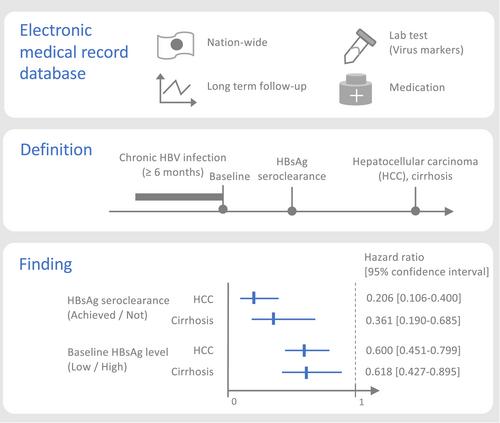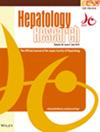A nation-wide medical record database study: Value of hepatitis B surface antigen loss in chronic hepatitis B patients in Japan
Abstract
Aim
Hepatitis B surface antigen (HBsAg) seroclearance is considered to be one of the best surrogate endpoints of functional cure for hepatitis B virus (HBV) infection. However, evidence regarding the relationship between achieving HBsAg seroclearance or a low baseline HBsAg level, and long-term clinical outcomes in Japanese patients with chronic HBV infection remains to be confirmed in a real-world setting.
Methods
A retrospective observational cohort study was performed with an electronic medical record database, including data from 230 hospitals across Japan. Chronic HBV infection was defined as two consecutive, positive HBsAg laboratory measurements for HBV infection. The date of the second positive was used as a baseline to identify subsequent HBsAg seroclearance and liver disease progression.
Results
In the database, 2523 patients with chronic HBV infection were identified as the chronic hepatitis B (CHB) cohort. Among the CHB cohort with an average observational period of 5.19 ± 3.87 years, 202 patients (8%) achieved HBsAg seroclearance after baseline. They had a lower risk of developing hepatocellular carcinoma (HCC) (adjusted hazard ratio [aHR] 0.206, p < 0.01) and cirrhosis (aHR 0.361, p < 0.01). When the CHB cohort was stratified into two groups based on baseline HBsAg levels (<100 IU/mL and ≥100 IU/mL), patients with a lower baseline level of HBsAg (<100 IU/mL) had a lower risk of developing liver disease (HCC aHR 0.600, p < 0.01; cirrhosis aHR 0.618, p < 0.05).
Conclusions
These results confirm the clinical significance of HBsAg seroclearance and low HBsAg level at baseline with respect to long-term outcomes of patients with CHB in the Japanese population.


 求助内容:
求助内容: 应助结果提醒方式:
应助结果提醒方式:


